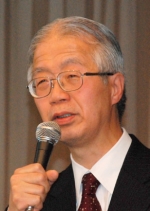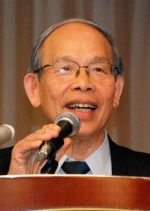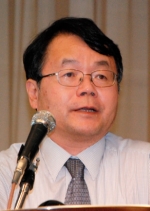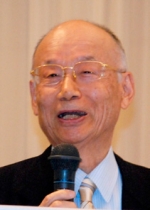December 03, 2012
The 124th
"Environmental Policy and Sustainable Management" ─Creating Future Technology by Ecodesign
December 3, 2012 at Tokyo Kaikan
"Environmental Policy and Sustainable Management" ─Creating Future Technology by Ecodesign
December 3, 2012 at Tokyo Kaikan
As global warming increases, the world experiences unusual weather that causes natural calamities like massive floods, mega tornados, and huge droughts. An IPCC's 2007 report concludes anthropogenic greenhouse gases are the primary cause of global warming, and many research organizations have proved it is true. It has been said, when the earth's surface temperature rises 2 degrees C from the preindustrial level, mega water shortages, famines, loss of Arctic sea ice in summer and other catastrophic damages are likely to collapse both the natural and human environments. To avoid such grave consequences, the '2 degrees C climate target' has been set and many governments and large corporations either plan to invoke or have already invoked necessary countermeasures. While Japan and European countries strive for CO2 reduction, China and the United States, the world's No. 1 and No. 2 CO2 emitting countries respectively, are reluctant and the world as a whole trembles in balance. So in the corporate world, management needs to be aware all their business activities occur in a compartment between the planetary and social boundary conditions. Going forward 'absolute management of environment' is necessary for companies to thrive by merchandising more and more environmentally-benign 'ecoproducts.' We also need to overcome the boundaries between traditional religions by sharing the spirit of 'ecobelief,' a wish to preserve the earth so 30 million different creatures continue to prosper. And this may channel the society into a shift to the 21st century equivalent of Max Weber's ethical foundation that nurtures the spirit of natural capitalism.
Dr. Ryoichi Yamamoto
Professor Emeritus at the University of Tokyo
Professor Emeritus at the University of Tokyo

October 01, 2012
The 123rd
"Nature Utilizes Fluctuation and Yet Avoids Wasteful Entropy"
October 1, 2012 at Tokyo Kaikan
"Nature Utilizes Fluctuation and Yet Avoids Wasteful Entropy"
October 1, 2012 at Tokyo Kaikan
The groundwork for modern physics in Japan was laid by Dr. Yoshio Nishina. Many postwar students including myself were drawn to physics when many Japanese physists, such as Dr. Hideki Yukawa won the Nobel Prize. At the university I focused on studying the relationships between phase transition and entropy. After publishing the scaling theory of order formation from unstable states in 1976, I was given an opportunity to do a guest lecture and two-hour discussion in an international conference, which gave me great leverage. I was really lucky to have been able to study under scientific giants like Dr. Ryogo Kubo who is famous for Kubo Theory on linear response and Nobel Prize winner Dr. Ilya Prigogine. All these experiences helped me a lot discover a new variational principle to derive irreversible and nonlinear steady states in transport phenomena. This new principle can be applied to many areas: You might want to use it for designing complex electric circuits, or for finding possible solutions to energy-related issues. Theoretical physic may not help people and society instantly, but it is extremely important in the long run. I hope younger researchers will play active roles, and I myself will continue my research to help build a society in harmony with the laws of nature.
Dr. Masuo Suzuki
Professor Emeritus at the University of Tokyo
Professor Emeritus at the University of Tokyo

July 23, 2012
The 122nd
"Innovative Materials Science for Sustainable Society"
July 23, 2012 at Tokyo Kaikan
"Innovative Materials Science for Sustainable Society"
July 23, 2012 at Tokyo Kaikan
There are more than 100 different elements on the earth, and the abundance of each element differs greatly thus only about 60 elements can be used for materials. Humans are destined to contrive new materials under this restriction. In recent materials science more published articles and patents come from China and the country gets ahead of the longtime leader Japan amid the rare earths crisis. To get out of this disturbing situation, we developed a scheme that uses common elements for creating new functions helpful for building a sustainable society, which has later become a government initiative called Element Strategy. I myself got involved in the making of the C12A7 electride, an insulation cement compound which can be transformed into a semiconductive, superconductive, and transparent metal material. This kind of new discovery is only possible when you renew your approach to studying elements from a cross-disciplinary perspective. While implementing the Element Strategy is quite challenging, it is a great opportunity for Japan to foster younger researchers in a competitive environment and to recoup lost ground. I hope this project will spawn exciting studies one after another that would make great social contributions.
Dr. Hideo Hosono
Professor, Frontier Research Center, Tokyo Institute of Technology
Professor, Frontier Research Center, Tokyo Institute of Technology

March 30, 2012
The 121st
"What Pioneering Crossborder Collaboration Brought to Us"─The Discovery of Avermectin / Ivermectin and Its Subsequent Development
March 30, 2012 at Tokyo Kaikan
"What Pioneering Crossborder Collaboration Brought to Us"─The Discovery of Avermectin / Ivermectin and Its Subsequent Development
March 30, 2012 at Tokyo Kaikan
As a natural organic compound researcher over years, Dr. Omura has discovered some 450 different compounds. Ivermectin is the most famous among 25 compounds that are currently used for medical drugs, animal drugs, pesticides and test reagent worldwide. He developed it from the soil actinomycetes taken in Shizuoka Prefecture when he worked with the American drug giant Merck & Co under a joint research program. This kind of industry-academia collaboration was rare at that time, but he entered the agreement to improve low-budget research environment. Ivermectin showed dramatic effects in a single dose, and soon became the world's biggest selling antiparasitic drug for animals. Currently WTO works to eradicate tropical diseases such as onchocerciasis and lymphatic filariasis, taking advantage of recently found efficacy of ivermectin to humans. Dr. Omura has used royalty income from ivermectin drugs for advanced research facilities, hospital renovation, and fostering of younger researchers. He always tries to set high goals and blaze a new trail toward greater human welfare.
Dr. Satoshi Omura
President Emeritus, Kitasato Institute
President Emeritus, Kitasato Institute







